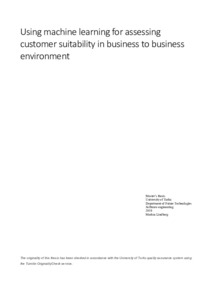Using machine learning for assessing customer suitability in business to business environment
Lindberg, Markus (2019-06-04)
Using machine learning for assessing customer suitability in business to business environment
Lindberg, Markus
(04.06.2019)
Julkaisu on tekijänoikeussäännösten alainen. Teosta voi lukea ja tulostaa henkilökohtaista käyttöä varten. Käyttö kaupallisiin tarkoituksiin on kielletty.
avoin
Julkaisun pysyvä osoite on:
https://urn.fi/URN:NBN:fi-fe2019061119907
https://urn.fi/URN:NBN:fi-fe2019061119907
Tiivistelmä
The industry has gone through multiple revolutions as a result of advancements in technology. Now, it might be on the verge of another one because of machine learning. In business to business setting, sales processes include many manual tasks. They consume a lot of time, that could otherwise be used for deepening relationships with customers or for acquiring new ones. Machine learning could be used to support and automate these tasks. Also, it could be used to forecast how a sales process ends.
This thesis proposes a new approach for using machine learning in the said environment. Instead of using sales data to just predict the outcomes of active sales processes, it is used to estimate how good a potential customer would be for a company. With these kinds of estimates, a company could more effectively screen the customers making their sales efforts potentially more profitable. The thesis aims to research questions that arise from this approach. These include the question of how to provide suitability estimates without saved data, when to start using machine learning for providing the estimates and how to maintain the performance of selected machine learning method. In the thesis, an open business to business dataset is used. It is introduced and analyzed. Also, a selection of machine learning models is introduced and one of them selected for the thesis. To answer the open questions of the thesis code is developed and tested. The code forms a two-mode system for providing suitability estimates. The purpose of the code was to verify the ideas useful for such a system.
As results of the thesis it can be stated that without saved data it is possible to offer suitability estimates by defining an optimal customer and comparing all the new customers to it. The system can start using machine learning once a classifier fitted to the data gives good enough cross-validation results. Once a machine learning model is in use, its performance can be maintained by retraining the model and finding the optimal parameters each time the dataset has changed. Finally, it is however stressed that the suitability estimates are not absolute truths. They should not be used blindly, but as decision support when selecting new customers for a company.
This thesis proposes a new approach for using machine learning in the said environment. Instead of using sales data to just predict the outcomes of active sales processes, it is used to estimate how good a potential customer would be for a company. With these kinds of estimates, a company could more effectively screen the customers making their sales efforts potentially more profitable. The thesis aims to research questions that arise from this approach. These include the question of how to provide suitability estimates without saved data, when to start using machine learning for providing the estimates and how to maintain the performance of selected machine learning method. In the thesis, an open business to business dataset is used. It is introduced and analyzed. Also, a selection of machine learning models is introduced and one of them selected for the thesis. To answer the open questions of the thesis code is developed and tested. The code forms a two-mode system for providing suitability estimates. The purpose of the code was to verify the ideas useful for such a system.
As results of the thesis it can be stated that without saved data it is possible to offer suitability estimates by defining an optimal customer and comparing all the new customers to it. The system can start using machine learning once a classifier fitted to the data gives good enough cross-validation results. Once a machine learning model is in use, its performance can be maintained by retraining the model and finding the optimal parameters each time the dataset has changed. Finally, it is however stressed that the suitability estimates are not absolute truths. They should not be used blindly, but as decision support when selecting new customers for a company.
